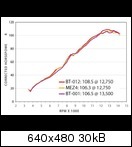Sofern man der Englischen Sprache ein weinig mächtig ist, nachfolgend mal ein paar Zeilen zu einem Test.
Hier der Link dazu
For better or worse, tall tales and inflated stories follow the streetbike scene like white on rice. When we repeatedly heard of 10 HP gains from a 520-chain swap we decided to investigate the claims.
For those unaware, streetbike chains come in many forms; from different sizes to O-ring or non O-ring designs. Most bikes are equipped with a 525 chain, and as the displacement and power increases so does the chain size, eventually reaching a 530. As designs go, non O-ring chains tend to be more efficient, but don’t last as long since the lack of rubber rings increases wear. As a result, most streetbikes use O-ring chains for longevity’s sake while racebikes and dirtbikes trade durability for maximum power.
As chain technology has progressed so has the strength of the metal ropes, and in recent years racers and street riders have discovered that even larger bikes equipped with a hefty 530 chain from the factory can safely swap to a lighter 520 setup. Swapping to the smaller, narrower combo not only drops weight, but the lack of material also cuts down on friction and increases power—so the myth goes.
With the same gear ration...
read full caption
The test
Since exactness had to be a priority we ensured that all dyno runs were made on the same dyno over the course of roughly 45 minutes. In addition to dyno pulls at normal oil and coolant operating temperatures, we also took the average of three timed fourth gear acceleration runs from 25-125 MPH.
A Kawasaki Ninja 1000 was brought up to temp and then run through the aforementioned tests. After the baseline numbers were determined we left the bike strapped on the dyno and replaced the OEM equipment with the RK 520 GXW chain and Vortex CAT5 sprockets. To keep the results as accurate as possible the gearing remained the same (15/41) since a smaller or larger sprocket creates more or less chain wrap, thus altering the numbers due to frictional changes.
In addition to the dyno and acceleration tests, all stock and aftermarket components were weighed on the same scale.
Myth: Confirmed
When the smoke cleared and the averages were calculated, the Ninja 1000 gained 1.5 HP and 1.4 LB-FT at the rear wheel and knocked off .05 seconds in the 25-125 MPH fourth gear dyno acceleration test.
Although the increases were small, it’s proof that a 520 conversion—without changing the gearing—does improve performance. The dyno results and acceleration tests were consistently better than the stock setup, and the 1.8-pound weight savings is a plus. In addition to the increased performance, the aesthetical improvements are reason enough to make the swap.
Only you can be the judge if such a setup is in your future, but we can safely say a 520 conversion is a beneficial mod. In reality we wouldn’t waste a perfectly good stock chain and sprockets. Instead use your current combo until it’s worn out, then make the change. As for the claims of 10 HP or more, leave those for the bench racers–a 520 conversion won’t drastically alter performance, but every little bit helps.
--------------------------------------------------------------------------------
Average horsepower and torque over three runs
Stock: 118.2 HP/70.5 LB-FT
520 Conversion: 119.7 HP/71.9 LB-FT
Average time for fourth gear 25-125 MPH acceleration test
Stock: 5.2 seconds
520 Conversion: 5.15 seconds
Stock component weights
530 Chain: 4.8 pounds
Countershaft sprocket: 0.50 pounds
Rear sprocket: 1.8 pounds
Total: 7.1 pounds
RK and Vortex component weights
520 Chain: 4.1 pounds
Countershaft sprocket: 0.4 pounds
Rear sprocket: 0.8 pounds
Total: 5.3 pounds
1.8 Total Pounds Saved.
Read more: http://www.superstreetbike.com/howtos/1 ... z2OjEsigvf" onclick="window.open(this.href);return false;

